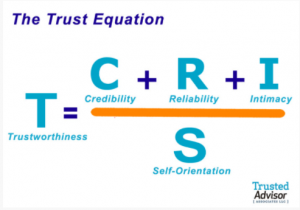12 Building Trust in Teams – Conclusion
In this module, you learned about the following:
The importance of trust
- Can be a problem in group projects
- When it doesn’t exist, people may protect themselves and their interests only
- Builds psychological safety, increases questioning, stronger constructive feedback, increases goodwill, faster results, increased knowledge-sharing
Measuring Trust
- Charles H. Green has created a model to quantify trust:

Some tips to improve trustworthiness through this model include
- Do your homework/ preparation
- Be honest, transparent, accurate
- Ask smart questions
- Follow through on promises
- Be vulnerable
- React to emotions
- Be curious
- Lead with calm
Building Trust
Other methods to improve trust include:
- Lead by example
- Look at your group members as people
- Intentionally build relationships
- Avoid placing blame
- Discuss trust issues
- Provide recognition
- Allow freedom in working styles
- Share information transparently
- Embody fairness
Psychological Safety
- Psychological Safety is “shared belief that the team is safe for interpersonal risk-taking”
- It has 4 levels:
- Inclusion Safety: Team members have a sense of belonging
- Learner Safety: Team members feel safe to engage in the learning process
- Contributor Safety: Team members feel safe to contribute meaningfully
- Challenger Safety: Team members feel comfortable challenging the status quo
Creating Psychological Safety
There are multiple methods to creating psychological safety
- Be Engaged
- Avoid blaming
- Inclusive decision-making
- Be open to feedback
- Be vulnerable
Trust and Communication
Trust & communication are interconnected
| Closing Note:
It may sometimes be difficult to develop trust within your group project. However, there are multiple actions you can take to facilitate its growth. We hope that you are able to use the content of this module to help contribute to a team that is built on mutual trust and support. |

